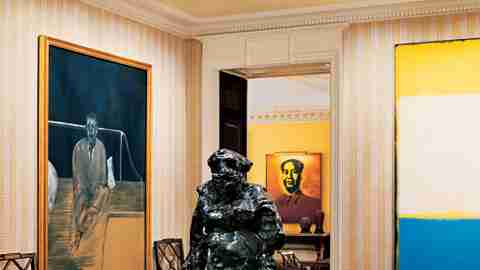Now and Then In Manhattan
View Slideshow

Every apartment is an autobiography. Elegant or edgy, Louis XIV or Pop, the surroundings people create tell the stories of their lives. "I was trying to build something cozy," architect Peter Marino says of an apartment he did for a Manhattan family whose narrative began in the 1970s with eighteenth-century Swedish antiques. "Then, bang , something else happened. That's what life is like. I don't believe in building false worlds."
The story begins with a young couple searching for a style. "We looked at everything," the wife remembers. "Then we saw a photograph in Peter's office, and it was like falling in love. We found Swedish design. Swedish is like French straightened out." Their first apartment chronicled their affair with the carved woods and ornate gilt details of eighteenth-century Sweden, Denmark and Russia. Marino filled the pale yellow and green rooms with mahogany-and-bronze Russian chairs and inlaid Swedish commodes and desks. They hung Danish still lifes by Johan-Laurents Jensen; eighteenth-century Tischbein the Elder portraits went with engravings by Boucher.
Then a few years ago, in order to have more room for their children, the couple moved to a larger apartment in a Regency-revival building near Central Park. The expanded space seemed to expand their aesthetic outlook. Bang, something else happened. "After we moved," the husband says, "we asked ourselves how we wanted to express ourselves in the new space. We began to think about other artists. We decided to make a list of the artists who were important and a list of the ones who pushed our hot buttons. We didn't just want pleasing pictures. We wanted pictures with punch."
Andy Warhol rose quickly to the top of the list. Marino approved. "I hammered them about Warhol," he says. "He was one of the masters of the twentieth century." The list included Roy Lichtenstein, Ellsworth Kelly, Willem de Kooning, Mark Rothko, Ed Ruscha, Picasso, Degas, Dubuffet, Léger, Matisse and, eventually, Francis Bacon and Francesco Clemente. One day soon after their names were decided upon, the husband was at an auction when a Warhol soup can painting— Beef Consommé —came up. "I bought it, and that was the beginning."
As the clients' collection grew, the "pictures with punch" moved in on the aristocratic Swedes like a clan of boisterous siblings. Warhols were hung over Neoclassical tables and eighteenth-century chairs. In the living room, an Ellsworth Kelly stretched out above a French tufted-velvet banquette. Warhol's somber portrait of Lenin was placed between two sections of a coromandel screen; over an Italian marble fireplace a Degas joined a Matisse and a Dubuffet.
"It's a more sophisticated game we're playing here than in their previous apartment," says Marino. "The juxtaposition of modern and antique works because they bought the best of each. When you combine good things, it makes good taste."
In the entrance gallery, the front door opened onto a huge wall, perfect for displaying contemporary art. Marino demurred. "It's not amusing to have six pictures in a row," he explains. Instead he broke up the wall and installed glass-and-mahogany doors leading to the library, where a Tischbein the Elder portrait of a man wearing a Venetian costume hangs over the mantel and a hand-printed Marino-designed wallcovering is a background for floral still lifes. A circa 1700 painting of a gallery in the Palazzo Borromeo overlooks a French red leather sofa and antique striped bourette-silk-covered armchairs. "This way what you see through those doors reflects the owners' growth," Marino says of the view from the gallery to the library. "You can see where they've been and where they are now."
To illuminate the gallery, the clients hired the firm that did the lighting for the Wrightsman Galleries of the Metropolitan Museum of Art. A spotlight heightens the powerful form of de Kooning's life-size bronze clam digger. Other artworks include a Picasso nude, flanked by Picasso and Léger drawings, and canvases by Bacon and Rothko.
In the dining room, an apocalyptic Ed Ruscha painting is set against hand-stenciled paneling above a Louis XVI sideboard, which is topped by a circa 1907 enamel-and-copper covered bowl inlaid with semiprecious stones. A Clemente nude is nearby. "Our new acquisitions have to meet three criteria," the husband points out. "They have to be by artists who have meaning for us; they have to fit into the space we're trying to create; and they have to relate to each other."
In the master bedroom, which is painted the shimmering shade of Swedish green the couple had in their former apartment, the past still holds sway. Tischbein's portrait of his wife hangs above a mantel that bears two Sèvres urns. A circa late-eighteenth-century Swedish secretary and a French commode from the same period face the bed.
"It's very much in the New York tradition that women rule with French taste in the bedroom, and the men rule in the other rooms," says Peter Marino. "My European clients are surprised by this kind of apartment. In Europe everything has to go together. I say to them, that's what it means to be in America. I tell them that's what being American is all about."